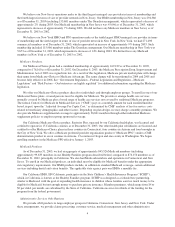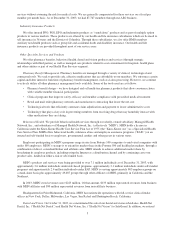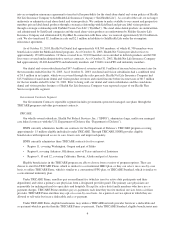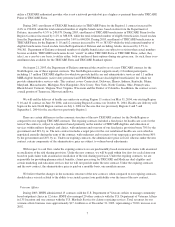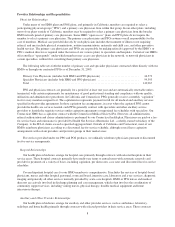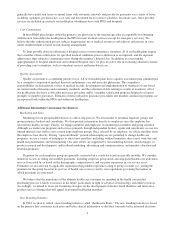Health Net 2003 Annual Report Download - page 16
Download and view the complete annual report
Please find page 16 of the 2003 Health Net annual report below. You can navigate through the pages in the report by either clicking on the pages listed below, or by using the keyword search tool below to find specific information within the annual report.reports with, and their operations are subject to periodic examination by, state licensing authorities. HMOs are required by
state law to meet certain minimum capital and deposit and/or reserve requirements in each state and may be restricted
from paying dividends to their parent corporations under some circumstances. Several states have increased minimum
capital requirements, in response to proposals by the National Association of Insurance Commissioners to institute risk-
based capital requirements. Regulations in these and other states may be changed in the future to further increase capital
requirements. Such increases could require us to contribute additional capital to our HMOs. Any adverse change in
governmental regulation or in the regulatory climate in any state could materially impact the HMOs operating in that state.
The HMO Act and state laws place various restrictions on the ability of HMOs to price their products freely. We must
comply with applicable provisions of state insurance and similar laws, including regulations governing our ability to seek
ownership interests in new HMOs, PPOs and insurance companies, or otherwise expand our geographic markets or
diversify our product lines.
Insurance Laws and Regulations
State departments of insurance (the “DOIs”) regulate our insurance and ASO businesses under various provisions of
state insurance codes and regulations. Our subsidiaries conducting these businesses are subject to various capital reserve
and other financial, operating and disclosure requirements established by the DOIs and state laws. These subsidiaries must
also file periodic reports regarding their regulated activities and are subject to periodic reviews of those activities by the
DOIs. We must also obtain approval from, or file copies with, the DOIs for all of our group and individual insurance
policies prior to issuing those policies.
Pending Federal and State Legislation
Patients’ Bill of Rights. In 2001, the United States Senate and House of Representatives passed separate bills,
sometimes referred to as “patients’ rights” or “patients’ bill of rights” legislation, that sought, among other things, to hold
health plans liable for claims regarding health care delivery and improper denial of care. This legislation would have
removed or limited federal preemption under ERISA that currently precludes most individuals from suing health plans for
causes of action based upon state law and would enable plan members to challenge coverage and benefits decisions in
state and federal courts. Although both bills provided for independent review of decisions regarding medical care, the bills
differed on the circumstances and procedures under which lawsuits could be brought against managed care organizations
and the scope of their liability. Congress did not ultimately enact legislation based on the 2001 bills and adjourned in 2002
without reconciling the two bills. Similar bills were introduced in both houses of Congress in 2003, and it is not known at
this time whether this issue will be debated in 2004. If patients’ bill of rights legislation is enacted into law, we could be
subject to significant additional litigation risk and regulatory compliance costs, which could be costly to us and could have
a significant adverse effect on our results of operations. Although we could attempt to mitigate our ultimate exposure to
litigation and regulatory compliance costs through, among other things, increases in premiums, there can be no assurance
that we would be able to mitigate or cover the costs stemming from litigation arising under patients’ bill of rights
legislation or the other costs that we could incur in connection with complying with patients’ bill of rights legislation.
There are a number of other legislative initiatives and proposed regulations currently pending or previously proposed
at the federal and state levels which could increase regulation of and costs incurred by the health care industry. These
measures, including the “patients’ bill of rights” and other initiatives, if enacted, could have significant adverse effects on
our operations. See “Risk Factors – Proposed federal and state legislation affecting the managed health care industry could
have an adverse effect on our operations” below. We cannot predict the outcome of any of the pending legislative or
regulatory proposals, nor the extent to which we may be affected by the enactment of any such legislation or regulation.
Service Marks
We have filed for registration of and maintain several service marks, trademarks and tradenames that we use in our
business, including marks and names incorporating the “Health Net” phrase. We utilize these and other marks and names
in connection with the marketing and identification of products and services. We believe such marks and names are
valuable and material to our marketing efforts.
Employees
As of December 31, 2003, Health Net and its subsidiaries employed 8,629 persons on a full-time basis and 424
persons on a part-time or temporary basis. These employees perform a variety of functions, including, among other things,
14


